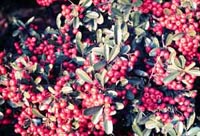Resource Library
Plant of the Week: Laland Pyracantha (Firethorn)
The University of Arkansas System Division of Agriculture does not promote, support or recommend plants featured in "Plant of the Week." Please consult your local Extension office for plants suitable for your region.
Plant of the Week
Laland Pyracantha, Firethorn
Latin: Pyracantha coccine a var. lalandei

Gardens have trends, fads and fashions just like every other part of our society.
When I started working 25 plus years ago there seemed to be an unwritten code that
every landscape in Arkansas required at least one pyracantha planted next to a blank
wall where it was trained in the espalier fashion.
Today you still see the concrete nails where many of these original plants were trained
but fashions have changed and the garden world has moved on to other more interesting
and exciting novelties.
Pyracantha is a large, evergreen woody shrub of the rose family that is closely allied
to the hawthorns and cotoneasters, yet distinctly different from them. The original
pyracantha plants made their way from southern Europe to England about 1600 where
they were grown as hedges and occasionally as small trees.
This species can become tree-like, often 15 feet tall and wide, but it doesn’t like
being as a tree -- it wants to be a bush when it grows up.
In the spring, masses of dirty white flowers are produced in dense terminal clusters.
But the main reason for growing pyracantha is not its flowers, but its drooping masses
of quarter-inch, orange-red berries that ripen in the fall and persist all winter.
The Laland pyracantha was grown from seed by a French nurseryman named M. Lalande
in 1874. It produces more fruit than the normal type and has been the most commonly
grown form during most of the last century. Donald Egolf, the former breeder at the
U.S. National Arboretum, worked with pyracantha and developed an upright growing selection
called "Mohave" which has become common in the trade today.
The name "pyracantha" is from Greek "pyr" meaning fire and "acanthos" meaning thorn,
hence its common name. Pyracantha has inchlong thorns nestled amongst the leaves that
gives a burning sensation when punctured that feels oh-so-good when the pain stops.
Apparently the plant exudes some type of salt from a gland on the thorn that imparts
the burning sensation.
The habit of training firethorns to walls is an 18th Century innovation that first
appeared in England and spread to this country soon thereafter. The use of espalier training is an old garden style coming from Italy where fruits and vines were trained
against walls. Apparently the pyracantha was the first ornamental to be grown in this
fashion.
Pyracanthas are not for the lazy gardener. If they are to be espaliered to a wall, they take fairly detailed pruning several times a year to keep the robust
plants in bounds.
While most of the common selections are hardy throughout Arkansas and they tolerate
our heat and dry summers well, they are not without their problems. The most serious
problem of pyracanthas is the disease fireblight that kills the plants back from the
tips.
A fruit disease, pyracantha scab, can be easily controlled by planting resistant
selections such as Mohave. The hawthorn lacebug also can attack the plant and make
its foliage unsightly. Because the plant is so vigorous these problems seldom kill
the plant, but they can make it unsightly enough to speed its removal.
By: Gerald Klingaman, retired
Extension Horticulturist - Ornamentals
Extension News - September 10, 1999
The University of Arkansas System Division of Agriculture does not maintain lists of retail outlets where these plants can be purchased. Please check your local nursery or other retail outlets to ask about the availability of these plants for your growing area.